高考英语 主谓一致,数词
(完整版)高考英语专题复习主谓一致(附答案)

高考英语专题复习主谓一致(附答案)I. 考点分析一、概述主谓一致是指句子成分之间或词语之间在人称、性、数等方面的一致关系。
处理主谓一致一般应遵循以下三条原则:1. 语法一致,即在语法形式上取得一致。
例如,主语为单数形式,谓语动词也为单数形式;主语为复数形式,谓语动词也采取复数形式。
a. The number of errors was surprising.b. Julia and her twin sister naturally look a lot alike.2. 意义一致,即从意义着眼处理一致关系。
a. The crowd were fighting for their lives. ( 单形名词主语要求复数谓语动词,下划线部分表示一个整体中的成员)b. Five minutes is enough. ( 复数名词单数谓语动词,下划线部分表示一个数目)3. 邻近原则,即指谓语动词的形式与邻近的名词一致。
a. A man of abilities are needed.(动词are不与主语a man一致,而与其邻近的复形名词abilities 形式上一致。
二、主谓一致注意要点:1. 当名词词组中心词为表示度量、时间等复数名词时,往往可根据意义一致的原则,把这些复数名词看作一个整体,谓语动词采取单数形式。
a. The dollars is not enough.b. Three months passes in no time at all on the ranch.如果明显地指一个个个体,则要根据语法一致地原则,谓语动词用复数形式。
a. There are two sliver dollars in each of the stockings.2. 如果名词词组中心词是all, most, half, the last, the rest, the remainder等词组时,其主谓关系一般遵循意义一致的原则:如所指为复数意义,谓语动词用复数形式;如所指为单数意义,则谓语动词用单数形式。
高考英语一轮 第2部分 第2讲 数词和主谓一致

twenty, thirty, forty, fifty, sixty, seventy, eighty, ninety
twenty-five, sixty-two, ninety-nine
three hundred and twenty-five(美语中常将 and 省略) 6275—six thousand two hundred and seventy-five ; 1200—twelve hundred
人教版高中英语一轮复习课件
二、序数词
范围
特点
1~19 各基数词尾加-th
20~90 21~99
Not only we but also the teacher likes listening to MP4. 不仅是我们,还有老师也喜欢听 MP4。
人教版高中英语一轮复习课件
12.不定代词(all 指人除外)、“many a+名词单数”、“more than one+单数名词”作主语时,谓语动词用单数。如:
人教版高中英语一轮复习课件
6.动名词、不定式或从句作主语时,谓语动词用单数。但 what 引导的主语从句视后面的表语而定。如:
What we need is time.我们需要的是时间。 What we need are books.我们需要的是书籍。 7 . 主语后接 with, together with, including, combined with, along with, as well as, but, except, besides, like, rather than, in addition to 等构成的介词短语时,谓语动词根据主语的单复数而 定。如:
高考英语主谓一致知识点总结
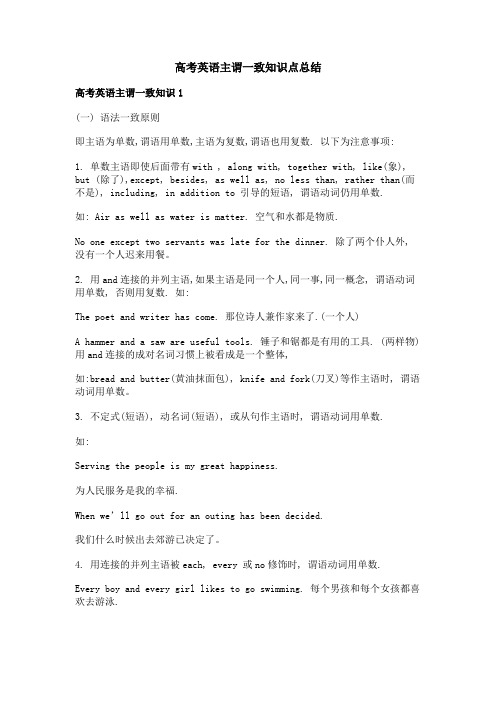
高考英语主谓一致知识点总结高考英语主谓一致知识1(一) 语法一致原则即主语为单数,谓语用单数,主语为复数,谓语也用复数. 以下为注意事项:1. 单数主语即使后面带有with , along with, together with, like(象), but (除了),except, besides, as well as, no less than, rather than(而不是), including, in addition to 引导的短语, 谓语动词仍用单数.如: Air as well as water is matter. 空气和水都是物质.No one except two servants was late for the dinner. 除了两个仆人外, 没有一个人迟来用餐。
2. 用and连接的并列主语,如果主语是同一个人,同一事,同一概念, 谓语动词用单数, 否则用复数. 如:The poet and writer has come. 那位诗人兼作家来了.(一个人)A hammer and a saw are useful tools. 锤子和锯都是有用的工具. (两样物)用and连接的成对名词习惯上被看成是一个整体,如:bread and butter(黄油抹面包), knife and fork(刀叉)等作主语时, 谓语动词用单数。
3. 不定式(短语), 动名词(短语), 或从句作主语时, 谓语动词用单数.如:Serving the people is my great happiness.为人民服务是我的幸福.When we’ll go out for an outing has been decided.我们什么时候出去郊游已决定了。
4. 用连接的并列主语被each, every 或no修饰时, 谓语动词用单数.Every boy and every girl likes to go swimming. 每个男孩和每个女孩都喜欢去游泳.No teacher and no student was absent from the meeting. 没有老师也没有学生开会缺席.Each man and (each) woman is asked to help. 每个男人和每个女人都被请去帮忙。
高中英语2025届高考语法复习句法知识讲解(主谓一致+动词时态+助动词)

高考英语语法复习句法知识讲解一、主谓一致在英文中,谓语的形式要与主语保持一致。
比如,你、我、他是学生,中文“是”字是一样的,只有主语不同。
英文的动词要根据主语不同而改变:I am,you are,he is。
主谓一致有三大原则:语法一致,意义一致,就近一致。
(一)语法一致名词是单数,谓语动词是单数。
不可数名词、集体名词、动词不定式、动名词等,谓语动词也用单数。
Knowledge is power. 知识就是力量。
The team is playing well. 这个团队表现得很好。
To see is to believe. 眼见为实。
Swimming is good exercise. 游泳是一项很好的运动。
记住:绝大多数都用单数,只有明确的复数名词,谓语动词才用复数。
My parents are teachers. 我的父母都是老师。
The shoes are all right. 这些鞋子很合适。
鞋、裤子、眼镜,只能是复数,如果前面加上“一双”“一条”,后面的动词就是单数。
A pair of glasses is very expensive. 一副眼镜很贵。
要想搞清楚谓语用单数还是复数,一定要准确锁定主语。
All except me in my family are going to the park. 很显然,all才是真正的主语,所以是复数。
She as well as the other girls is reading a book. 在这里,She才是真正的主语,所以是单数。
"more than one +名词"作主语时,谓语动词常用单数。
例如:More than one teacher gets the flowers."half of, the rest of, most of, all of, 百分数/分数+of +名词"作主语时,谓语动词形式根据of后的名词而定。
高中英语主谓一致讲解(整理版)
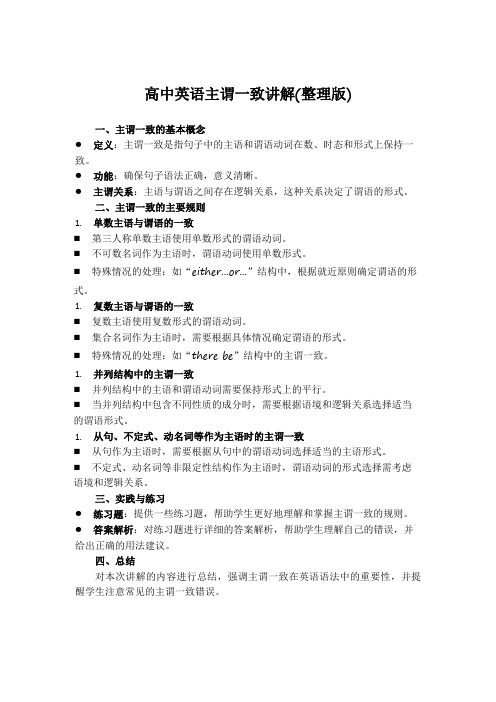
高中英语主谓一致讲解(整理版)
一、主谓一致的基本概念
●定义:主谓一致是指句子中的主语和谓语动词在数、时态和形式上保持一致。
●功能:确保句子语法正确,意义清晰。
●主谓关系:主语与谓语之间存在逻辑关系,这种关系决定了谓语的形式。
二、主谓一致的主要规则
1.单数主语与谓语的一致
⏹第三人称单数主语使用单数形式的谓语动词。
⏹不可数名词作为主语时,谓语动词使用单数形式。
⏹特殊情况的处理:如“either...or...”结构中,根据就近原则确定谓语的形式。
1.复数主语与谓语的一致
⏹复数主语使用复数形式的谓语动词。
⏹集合名词作为主语时,需要根据具体情况确定谓语的形式。
⏹特殊情况的处理:如“there be”结构中的主谓一致。
1.并列结构中的主谓一致
⏹并列结构中的主语和谓语动词需要保持形式上的平行。
⏹当并列结构中包含不同性质的成分时,需要根据语境和逻辑关系选择适当的谓语形式。
1.从句、不定式、动名词等作为主语时的主谓一致
⏹从句作为主语时,需要根据从句中的谓语动词选择适当的主语形式。
⏹不定式、动名词等非限定性结构作为主语时,谓语动词的形式选择需考虑语境和逻辑关系。
三、实践与练习
●练习题:提供一些练习题,帮助学生更好地理解和掌握主谓一致的规则。
●答案解析:对练习题进行详细的答案解析,帮助学生理解自己的错误,并给出正确的用法建议。
四、总结
对本次讲解的内容进行总结,强调主谓一致在英语语法中的重要性,并提醒学生注意常见的主谓一致错误。
数词和主谓一致
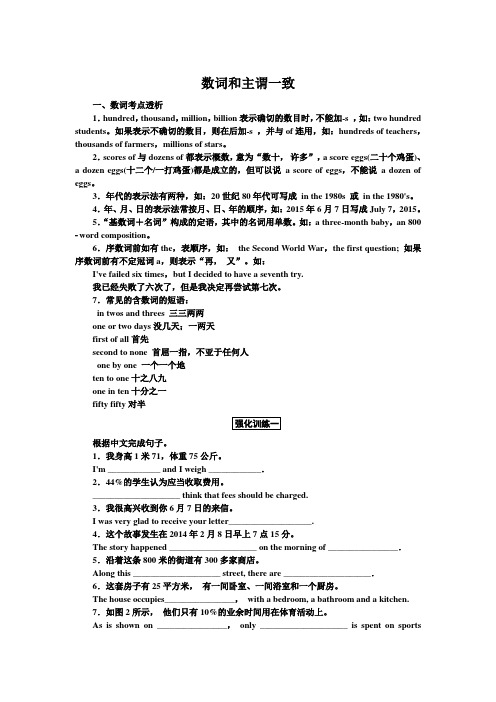
数词和主谓一致一、数词考点透析1.hundred,thousand,million,billion表示确切的数目时,不能加-s ,如:two hundred students。
如果表示不确切的数目,则在后加-s ,并与of连用,如:hundreds of teachers,thousands of farmers,millions of stars。
2.scores of与dozens of都表示概数,意为“数十,许多”,a score eggs(二十个鸡蛋)、a dozen eggs(十二个/一打鸡蛋)都是成立的,但可以说a score of eggs,不能说a dozen of eggs。
3.年代的表示法有两种,如:20世纪80年代可写成in the 1980s 或in the 1980's。
4.年、月、日的表示法常按月、日、年的顺序,如:2015年6月7日写成July 7,2015。
5.“基数词+名词”构成的定语,其中的名词用单数。
如:a three-month baby,an 800word composition。
6.序数词前如有the,表顺序,如:the Second World War,the first question; 如果序数词前有不定冠词a,则表示“再,又”。
如:I've failed six times,but I decided to have a seventh try.我已经失败了六次了,但是我决定再尝试第七次。
7.常见的含数词的短语:in twos and threes 三三两两one or two days没几天;一两天first of all首先second to none 首屈一指,不亚于任何人one by one 一个一个地ten to one十之八九one in ten十分之一fifty fifty对半强化训练一根据中文完成句子。
高考英语语法考点解读:主谓一致与数词
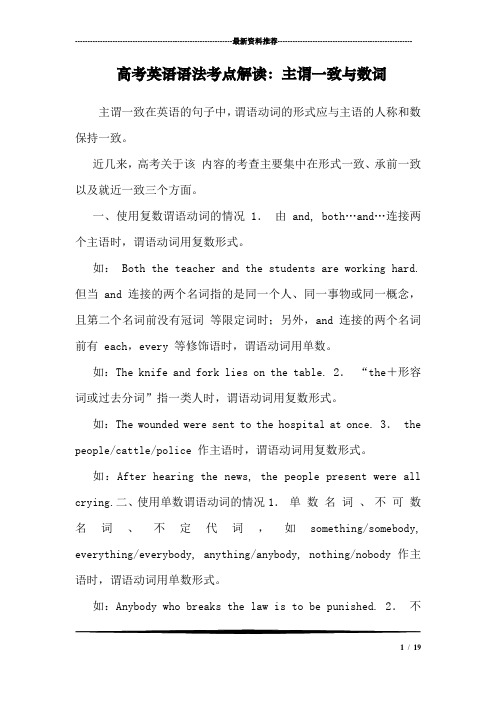
---------------------------------------------------------------最新资料推荐------------------------------------------------------ 高考英语语法考点解读:主谓一致与数词主谓一致在英语的句子中,谓语动词的形式应与主语的人称和数保持一致。
近几来,高考关于该内容的考查主要集中在形式一致、承前一致以及就近一致三个方面。
一、使用复数谓语动词的情况1.由and, both…and…连接两个主语时,谓语动词用复数形式。
如: Both the teacher and the students are working hard.但当 and 连接的两个名词指的是同一个人、同一事物或同一概念,且第二个名词前没有冠词等限定词时;另外,and 连接的两个名词前有 each,every 等修饰语时,谓语动词用单数。
如:The knife and fork lies on the table. 2.“the+形容词或过去分词”指一类人时,谓语动词用复数形式。
如:The wounded were sent to the hospital at once. 3. the people/cattle/police 作主语时,谓语动词用复数形式。
如:After hearing the news, the people present were all crying.二、使用单数谓语动词的情况1.单数名词、不可数名词、不定代词,如something/somebody, everything/everybody, anything/anybody, nothing/nobody 作主语时,谓语动词用单数形式。
如:Anybody who breaks the law is to be punished. 2.不1/ 19定式、动名词、主语从句作主语,谓语动词用单数形式。
高中英语真题:第3讲 数词、代词及主谓一致的5个歌诀与3种方法
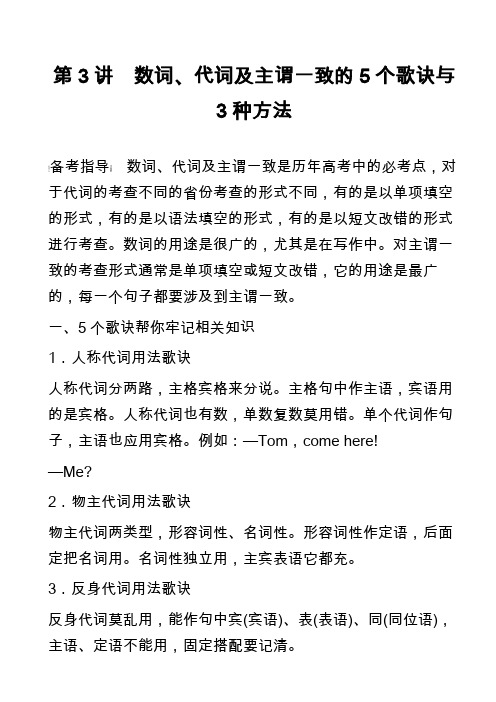
第3讲数词、代词及主谓一致的5个歌诀与3种方法备考指导数词、代词及主谓一致是历年高考中的必考点,对于代词的考查不同的省份考查的形式不同,有的是以单项填空的形式,有的是以语法填空的形式,有的是以短文改错的形式进行考查。
数词的用途是很广的,尤其是在写作中。
对主谓一致的考查形式通常是单项填空或短文改错,它的用途是最广的,每一个句子都要涉及到主谓一致。
一、5个歌诀帮你牢记相关知识1.人称代词用法歌诀人称代词分两路,主格宾格来分说。
主格句中作主语,宾语用的是宾格。
人称代词也有数,单数复数莫用错。
单个代词作句子,主语也应用宾格。
例如:—Tom,come here!—Me?2.物主代词用法歌诀物主代词两类型,形容词性、名词性。
形容词性作定语,后面定把名词用。
名词性独立用,主宾表语它都充。
3.反身代词用法歌诀反身代词莫乱用,能作句中宾(宾语)、表(表语)、同(同位语),主语、定语不能用,固定搭配要记清。
4.基数词变序数词歌诀一、二、三,特别例,结尾字母t,d,d。
th,四加起,八去t,九去e,y要用ie替。
ve必须变f,five,twelve是俩兄弟。
若是遇到几十几,只变个位就可以。
5.英语分数巧记歌诀英语分数不费事,“母序子基”四个字,分子若是大于一,分母还需加s。
二、3种解题方法方法1 明确指代法在解答代词题目时,我们应首先分析前后文,明确代词所指代的对象,从而避免误判。
具体说来应从以下几方面考虑:(1)代词指代的是人还是物;(2)代词指代的是可数名词还是不可数名词;(3)代词指代的是特指还是泛指概念;(4)代词指代的概念是表示两者之间还是三者或三者以上;(5)代词所表示的是肯定还是否定概念。
典例展示1 (2016·全国卷Ⅱ)It does not cost many, yet we can still learn a lot.________答案many→much解析本句中代词much代替不可数名词much money作动词cost的宾语,而many通常代替可数名词的复数形式。
备战2024年高考英语考试易错点04 数词和主谓一致(4大陷阱)(原卷版)
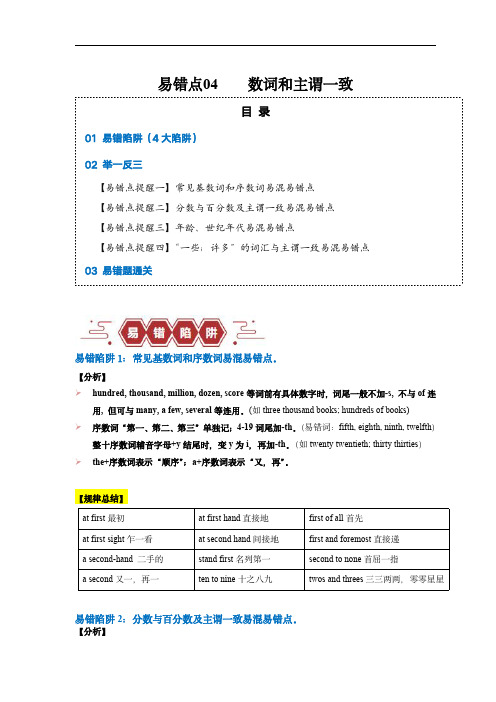
易错点04数词和主谓一致目录01易错陷阱(4大陷阱)02举一反三【易错点提醒一】常见基数词和序数词易混易错点【易错点提醒二】分数与百分数及主谓一致易混易错点【易错点提醒三】年龄、世纪年代易混易错点【易错点提醒四】“一些;许多”的词汇与主谓一致易混易错点03易错题通关易错陷阱1:常见基数词和序数词易混易错点。
【分析】hundred,thousand,million,dozen,score等词前有具体数字时,词尾一般不加-s,不与of连用,但可与many,a few,several等连用。
(如three thousand books;hundreds of books)序数词“第一、第二、第三”单独记;4-19词尾加-th。
(易错词:fifth,eighth,ninth,twelfth)整十序数词辅音字母+y结尾时,变y为i,再加-th。
(如twenty twentieth;thirty thirties)the+序数词表示“顺序”;a+序数词表示“又,再”。
【规律总结】at first最初at first hand直接地first of all首先at first sight乍一看at second hand间接地first and foremost直接递a second-hand二手的stand first名列第一second to none首屈一指a second又一,再一ten to nine十之八九twos and threes三三两两,零零星星易错陷阱2:分数与百分数及主谓一致易混易错点。
【分析】表示分数时,分子用基数词,分母用序数词。
分子大于1时,在分母后加-s。
(易错点:1/2不能用a second,应用a/one half)分数、百分数+of+名词作主语时,谓语动词的单复数由of后面的名词而决定。
易错陷阱3:年龄、世纪年代易混易错点。
【分析】表示“某人多大年龄”用“at the age of+基数词”或“基数词+years old”或“基数词+years of age”表示“某人几十多岁时”,用in one’s+整十基数词的复数(如in his thirties)表示“......世纪年代时”,用in the+世纪年代s/世纪年代’s(in the1980s/1980’s)易错陷阱4:“一些;许多”的词汇与主谓一致易混易错点。
天津高考英语知识点大纲

天津高考英语知识点大纲导语:天津高考英语是中国高考中的重要科目之一,对于学生来说,掌握英语知识点是取得高分的关键。
本文将介绍天津高考英语知识点大纲,帮助学生更好地备考。
一、语法知识点1. 时态天津高考英语中常考的时态有一般现在时、一般过去时、一般将来时等。
学生需要熟悉各个时态的用法及其动词形式的变化。
2. 从句从句是天津高考英语常考的一个知识点。
包括宾语从句、定语从句、状语从句等,学生需要了解从句的构成、用法以及连接词的用法。
3. 主谓一致主谓一致是指主语与谓语动词在人称和数上的一致。
学生需要掌握主谓一致的规则,特别是当主语是复数名词、不可数名词、连接词或代词时的一致规则。
4. 介词和介词短语介词是用来表达时间、地点、方式等关系的词语。
学生需要掌握各类介词的用法,以及介词短语在句子中的位置和作用。
5. 数词和冠词数词和冠词是天津高考英语常考的知识点。
学生需要了解基数词、序数词、分数词的用法,以及冠词a/an、the的用法。
二、词汇知识点1. 同义词和反义词天津高考英语中经常考察同义词和反义词的用法。
学生需要掌握一些常用的同义词和反义词,以便在阅读理解和写作中正确运用。
2. 词根词缀词根词缀是构成英语单词的基础部分,理解词根词缀的含义可以帮助学生记忆更多的单词。
学生需要了解常见的词根词缀及其含义。
3. 习惯用语和固定搭配习惯用语和固定搭配是天津高考英语中常见的考点。
学生需要掌握一些常用的习惯用语和固定搭配,以便在写作和听力中更流利地表达自己的意思。
三、阅读理解知识点1. 推理判断天津高考英语阅读理解常考推理判断题型。
学生需要通过阅读材料获取相关信息,进行推理判断,选择正确答案。
2. 词义猜测天津高考英语阅读理解中经常要求学生根据上下文猜测词义。
学生需要通过上下文的提示,结合词汇知识和语法知识来推断词义。
3. 主旨大意天津高考英语阅读理解常考主旨大意题型。
学生需要通过阅读材料找到文章的主题和核心内容,选择正确答案。
高考英语一轮复习之名词数词和主谓一致
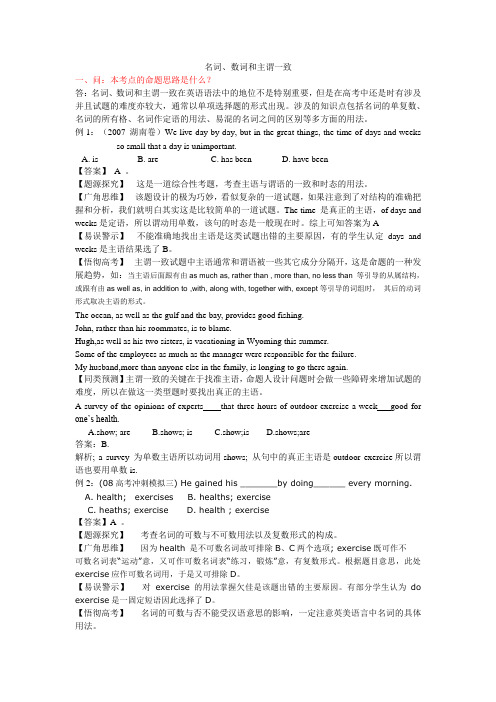
名词、数词和主谓一致一、问:本考点的命题思路是什么?答:名词、数词和主谓一致在英语语法中的地位不是特别重要,但是在高考中还是时有涉及并且试题的难度亦较大,通常以单项选择题的形式出现。
涉及的知识点包括名词的单复数、名词的所有格、名词作定语的用法、易混的名词之间的区别等多方面的用法。
例1:(2007 湖南卷)We live day by day, but in the great things, the time of days and weeks _________ so small that a day is unimportant.A. isB. areC. has beenD. have been【答案】A 。
【题源探究】这是一道综合性考题,考查主语与谓语的一致和时态的用法。
【广角思维】该题设计的极为巧妙,看似复杂的一道试题,如果注意到了对结构的准确把握和分析,我们就明白其实这是比较简单的一道试题。
The time 是真正的主语,of days and weeks是定语,所以谓动用单数,该句的时态是一般现在时。
综上可知答案为A【易误警示】不能准确地找出主语是这类试题出错的主要原因,有的学生认定days and weeks是主语结果选了B。
【悟彻高考】主谓一致试题中主语通常和谓语被一些其它成分分隔开,这是命题的一种发展趋势,如:当主语后面跟有由as much as, rather than , more than, no less than 等引导的从属结构,或跟有由as well as, in addition to ,with, along with, together with, except等引导的词组时,其后的动词形式取决主语的形式。
The ocean, as well as the gulf and the bay, provides good fishing.John, rather than his roommates, is to blame.Hugh,as well as his two sisters, is vacationing in Wyoming this summer.Some of the employees as much as the manager were responsible for the failure.My husband,more than anyone else in the family, is longing to go there again.【同类预测】主谓一致的关键在于找准主语,命题人设计问题时会做一些障碍来增加试题的难度,所以在做这一类型题时要找出真正的主语。
数词和主谓一致-5年高考

17.A〖考点〗本题考查主谓一致及动词的时态。〖解析〗根据句意,此处应用被动语态,不用主动语态,故排除B;又因为when and where表示单数意义,故排除D;再根据句末的yet可知,最好用现在完成时,故选A最佳。
A. are;are B. is;is C. are;is D. is:are
6.〖09山东〗Thenumber of foreign students attending Chinese universities _______ rising steadily since1990.
A. is B. are C. has been D. have been
五年高考【2007-2011】----数词与主谓一致
数词在高考中的考查重点:
1.基数词的确指和不确指;
2.数词与主谓一致关系;
3.dozen和score的用法;
最常见的形式是主谓一致的考查;分数和百分数作主语、数量词作主语仍将是考查重点(as well as; together with; along with; not only…but also…; rather than; neither…nor…; either…or…;the number of与a number of等要特别关注);
A.isB.areC.has beenD.have been
15.〖07陕西〗As a result of the serious flood, two-thirds of the buildings in the area.
高考英语语法 主谓一致及练习

一.主谓一致的基本原则1.语法一致:指主语用单数形式,谓语也用单数形式;主语为复数,谓语动词也用复数。
2.意义一致:指主语形式上是单数,但表达复数意义,那么谓语动词要用复数形式;或主语形式上是复数形式但表达单数意义,则谓语动词也采用单数形式。
eg:My family were watching TV at 7 o’clock.3.就近原则:指谓语动词的人称和数由最靠近它的主语决定。
eg: There are two pens, a book and three pencils on the desk.二.谓语动词只能用单数的12种情况1.非谓语动词或从句做主语to do, 疑问词+to do , 动名词doing, 或主语从句做主语(what引导的从句有例外),谓语动词用单数。
eg: when and where to build the new factory is not decided yet.2. 复合不定代词作主语以some-,any-,every-,no-开头,以-thing,-body,-one结尾的复合不定代词作主语时,谓语动词用单数。
Eg: Nobody wants to go there, does he?Something has been done to end the strike.3. 以-s结尾的学科名,书名,国名做主语eg: physics, politics,maths,the United States, Wales4. “more than one/many a+单数名词”作主语时位于动词用单数。
但是在more+复数名词+than one后谓语动词用复数eg: More than one student has seen the film.5. 指同一人或事物的并列结构作主语指同一人或事物的A and B结构(如knife and fork刀叉, bread and butter 黄油面包,a teacher and writer老师兼作家)作主语时,谓语动词用单数。
数词和主谓一致

一、数词 1.基数词的结构特点: (1)在表达上十位和个位之间要加连字符“-”。 (2)在百位和十位之间要用 and 连接。 (3)千位以上的数从后向前数,每三位加一个逗号。 (4)hundred,thousand,million 等前面有具体数字或
some,several 等修饰时,后面不加“s”;但当其后跟 of 短语时,要用复数形式。
特别提醒:①what 从句做主语时,谓语动词的形式主要取 决于后面的表语是单数还是复数。试比较:
What they want is nothing but a rest. What he wants are two books. ②当 what 从句表示所说的话或所做的事时,谓语动词应用
单数。例如: What he said has left us much to think about.
(4)主语是形复意单的词 ①以 s 结尾的国名、人名、书名、组织机构等专有名词作主语时。例如: The United Nations(联合国) was founded in 1945. ②以 s 结尾的学科名词做主语时。例如: Physics is taught in all middle schools. ③“One and a half+复数名词”做主语时。例如: One and a half days is all I can spare.
这一结构做主语时。例如: The Chinese are a brave and hardworking people.
(2)主语是形复意复的词 ①某些具有抽象意义的复数名词做主语时。例如: Things are getting worse and worse. The surroundings are usually quiet here. ②“one or two+复数名词”做主语时。例如: There are one or two tickets left.
成人高考英语数词作主语时的主谓一致复习资料
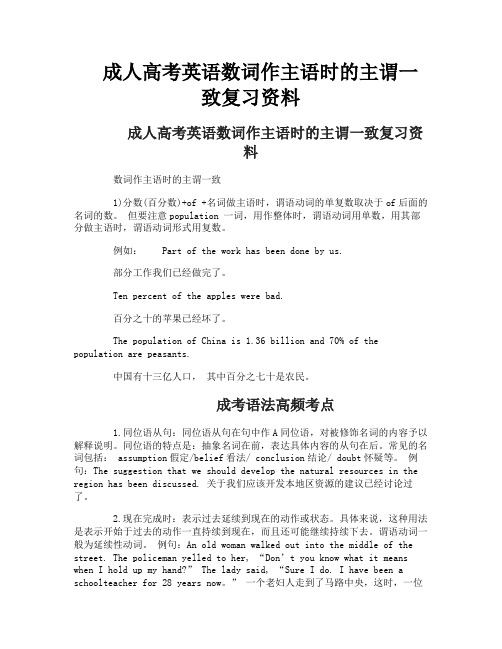
成人高考英语数词作主语时的主谓一致复习资料成人高考英语数词作主语时的主谓一致复习资料数词作主语时的主谓一致1)分数(百分数)+of +名词做主语时,谓语动词的单复数取决于of后面的名词的数。
但要注意population 一词,用作整体时,谓语动词用单数,用其部分做主语时,谓语动词形式用复数。
例如:Part of the work has been done by us.部分工作我们已经做完了。
Ten percent of the apples were bad.百分之十的苹果已经坏了。
The population of China is 1.36 billion and 70% of the population are peasants.中国有十三亿人口,其中百分之七十是农民。
成考语法高频考点1.同位语从句:同位语从句在句中作A同位语,对被修饰名词的内容予以解释说明。
同位语的特点是:抽象名词在前,表达具体内容的从句在后。
常见的名词包括: assumption假定/belief看法/ conclusion结论/ doubt怀疑等。
例句:The suggestion that we should develop the natural resources in the region has been discussed. 关于我们应该开发本地区资源的建议已经讨论过了。
2.现在完成时:表示过去延续到现在的动作或状态。
具体来说,这种用法是表示开始于过去的动作一直持续到现在,而且还可能继续持续下去。
谓语动词一般为延续性动词。
例句:An old woman walked out into the middle of the street. The policeman yelled to her, “Don’t you know what it means when I hold up my hand?” The lady said, “Sure I do. I have been a schoolteacher for 28 years now。
主谓一致高中英语语法与短语

主谓一致高中英语语法与短语主谓一致时,什么时候谓语用单数?什么时候用复数?如何学好英语?小编在这里整理了相关资料,快来学习学习吧!一主谓一致概念一、主谓一致概念:主谓一致,即谓语动词的单复数要和主语保持一致。
一般来说,如果主语是单数形式,那么谓语动词要用单数;如果主语是复数形式,那么谓语动词要用复数。
但是,也会出现一些特殊情况,这就是我们要总结的。
二主谓一致类型1. 不可数名词看成单数,因此谓语动词要用单数形式。
不可数名词有很多,比如空气、水、重量、长度、金钱等等。
(1) Ten thousand dollars is quite a large sum.(2) About 20 percent of the work was done yesterday.第一个句子里,钱即使再多,也只是一笔数目,所以看成单数;第二个句子里,work 是不可数的,这个要注意,在英语里,我们把 job 看成可数名词,但是 work 看成不可数名词,不可数名词的前提下,不论讲它的几分之几,还是百分之多少,都仍然是不可数。
2. 主语从句看成单数。
That they were wrong in these matters is now clear to us all.这句话里有两个动词,一个是were,另一个是 is,一个句子只能有一个动词,所以这里肯定嵌入了一个从句,我们会发现 That they were wrong in these matters 是个整体,充当整个句子里的主语,所以是主语从句。
我们把主语从句看成单数,所以这里用的 is。
3. 就前原则就前原则,指的是动词单复数看这个词前面的名词单复数情况。
as well as, with, along with, together with 都遵循就前原则。
具体我们来看以下例句:(1) E-mail, as well as telephones, plays an important part in daily communication.(2) A library with five thousand books is offered to the nationas a gift.第一句话的意思是邮件和电话在日常沟通中有重要作用。
数词与主谓一致

高考冲刺复习:数词主谓一致学大教育一对一 . 英语辅导讲义数词一.基数词用法要点考点:1. hundred, thousand, million, billion, dozen, score 与具体的数词连用表示具体数目时,习惯上用单数,而且也不后接介词of。
如:注:当这些词后面的名词有了the, these, those等特指限定词修饰时,或其后的接的是us, them 这样的人称代词时,则此时必须用介词 of。
如:two dozen of these pens, three score of them, 2. 当以上词不与具体数字连用,而是后接of表示概数时,用复数。
如:hundreds of students, dozens of eggs(几十个鸡蛋),scores of pencils(几十根铅笔) The sun was shining. Thousands of people were lying on the beach. 阳光灿烂,数以千计的人躺在海滩上。
二.序数词用法要点考点序数词在句中可作主语、表语、宾语、同位语和状语等。
1.序数词表示顺序,是第几的意思,如:first(第一), second(第二), third(第三), fifth(第五), twelfth(第十二), twentieth(第二十)等。
2.序数词作主语,前面一般有定冠词。
The first is better than the second.第一个比第二个好。
3.序数词作宾语,前面一般有定冠词。
I like the second on the left.左边第二个。
He was among the first to arrive. 他是第一批到达的人。
(the first作介词among的宾语。
)4.序数词用作副词修饰动词时不加冠词。
When did you first meet him? 你第一次见到他是什么时候?5.序数词作同位语,前面须有定冠词。
2021年高考英语语法复习 数词和主谓一致考点总结及配套练习
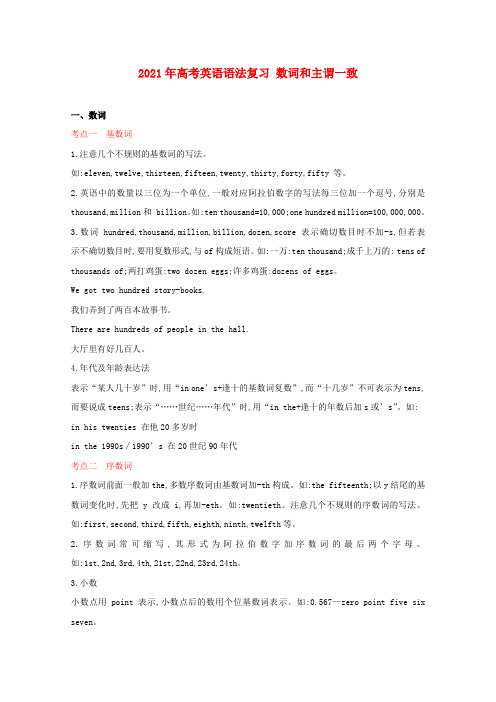
2021年高考英语语法复习数词和主谓一致一、数词考点一基数词1.注意几个不规则的基数词的写法。
如:eleven,twelve,thirteen,fifteen,twenty,thirty,forty,fifty 等。
2.英语中的数量以三位为一个单位,一般对应阿拉伯数字的写法每三位加一个逗号,分别是thousand,million和 billion。
如:ten thousand=10,000;one hundred million=100,000,000。
3.数词 hundred,thousand,million,billion,dozen,score 表示确切数目时不加-s,但若表示不确切数目时,要用复数形式,与of构成短语。
如:一万:ten thousand;成千上万的: tens of thousands of;两打鸡蛋:two dozen eggs;许多鸡蛋:dozens of eggs。
We got two hundred story-books.我们弄到了两百本故事书。
There are hundreds of people in the hall.大厅里有好几百人。
4.年代及年龄表达法表示“某人几十岁”时,用“in one’s+逢十的基数词复数”,而“十几岁”不可表示为tens,而要说成teens;表示“……世纪……年代”时,用“in the+逢十的年数后加s或’s”。
如: in his twenties 在他20多岁时in the 1990s∕1990’s 在20世纪90年代考点二序数词1.序数词前面一般加the,多数序数词由基数词加-th构成。
如:the fifteenth;以y结尾的基数词变化时,先把y改成i,再加-eth。
如:twentieth。
注意几个不规则的序数词的写法。
如:first,second,third,fifth,eighth,ninth,twelfth等。
2.序数词常可缩写,其形式为阿拉伯数字加序数词的最后两个字母。
- 1、下载文档前请自行甄别文档内容的完整性,平台不提供额外的编辑、内容补充、找答案等附加服务。
- 2、"仅部分预览"的文档,不可在线预览部分如存在完整性等问题,可反馈申请退款(可完整预览的文档不适用该条件!)。
- 3、如文档侵犯您的权益,请联系客服反馈,我们会尽快为您处理(人工客服工作时间:9:00-18:30)。
主谓一致在英语的句子中,谓语动词的形式应与主语的人称和数保持一致。
近几年来,高考关于该内容的考查主要集中在形式一致、承前一致以及就近一致三个方面。
一、使用复数谓语动词的情况1.由and, both…and…连接两个主语时,谓语动词用复数形式。
如:Both the teacher and the students are working hard.但当and 连接的两个名词指的是同一个人、同一事物或同一概念,且第二个名词前没有冠词等限定词时;另外,and连接的两个名词前有each,every等修饰语时,谓语动词用单数。
如:The knife and fork lies on the table.2.“the+形容词或过去分词”指一类人时,谓语动词用复数形式。
如:The wounded were sent to the hospital at once.3. the people/cattle/police作主语时,谓语动词用复数形式。
如:After hearing the news, the people present were all crying.二、使用单数谓语动词的情况1.单数名词、不可数名词、不定代词,如something/somebody, everything/everybody, anything/anybody, nothing/nobody作主语时,谓语动词用单数形式。
如:Anybody who breaks the law is to be punished.2.不定式、动名词、主语从句作主语,谓语动词用单数形式。
如:Looking after the baby is my job.3.学科名词,以-s结尾的单数名词,以-s结尾的书名、报纸杂志名、地方、组织名称作主语时,谓语动词用单数形式。
如:Physics is hard to study.4.单数名词+with, along with,together with,as well as,rather than, as much as,but, except, besides, such as, like, including等作主语时,谓语动词仍用单数形式。
如:Tom as well as two of his friends was invited to the party.三、使用就近原则的情况or, either…or, neither…nor, not only…but also, not…but连接两个主语时,谓语动词与靠近它的主语保持一致。
如:Either the students or their teacher dislikes basketball,otherwise they would take part in the basketball match.四、集体名词作主语时主谓一致的情况若看作一个整体,谓语动词用单数形式;若侧重于个体,谓语动词用复数形式。
常见的集体名词有:class, family,population, committee等。
如:The whole family are farmers.五、几个具体情况1. none作主语时,谓语动词多用复数形式,也可用单数形式。
如:None of this money is yours.None of these suggestions are very helpful.2.a number of+复数名词,谓语动词用复数形式,the number of+复数名词,谓语动词用单数形式。
如:A number of students study at home nowadays on weekends.The number of students in my class is 63.3. one of+复数名词,后面跟定语从句时,谓语动词用复数形式,即与复数名词一致;the (only) one of+复数名词,谓语动词用单数形式,即与the (only) one 一致。
如:He is one of the students who are against the plan.The only one of the students who is to be punished is Tom.4.“some+复数名词”作主语时,谓语动词用复数形式;some+单数名词作主语时,some意为“某个”,谓语动词用单数形式。
如:Some student is on duty today.Some students in my class are very lazy.5. trousers, shoes, glasses, scissors等复数名词作主语时,谓语动词用复数形式,但a pair of…的结构作主语时,谓语动词用单数形式。
如:This pair of glasses is expensive.6.单复数同形的名词作主语。
英语中一些单复数同形的名词作主语时,应根据其表达的意义来决定谓语动词的单复数,常见的这类名词有works(工厂),police(警察),sheep(绵羊),deer(鹿),fish(鱼),means(方法),species(种类),Chinese(中国人),Japanese(日本人);Swiss(瑞士人);series(系列)等。
如:Every possible means has been used to prevent the air pollution, but the sky is still not clear.7. what /whoever /which引导的主语从句充当主语时,有时要看what /whoever /which所指代的词的意义来决定谓语动词的数。
如:What he said is true.What we need are more volunteers.8.“分数(百分数)+of +名词”作主语时,谓语动词的形式要根据名词确定。
如:One-third of us are boys.Two-fifths of water is clear.9.“more than one /many a +单数名词”作主语时,尽管其意义复数,但谓语动词还是用单数形式。
但“more than +复数名词”作主语时,谓语动词要用复数。
数词数词分为基数词、序数词、分数、小数和概数。
复习时要注意下面问题:1.基数词的意义:表示事物数量的多少,特别是hundred,thousand,million 等,前面若有基数词或某些表示数量的形容词时,它们只能用单数。
2.序数词一般由基数词+th构成。
以y结尾的基数词构成序数词时,先把y变为i,再加eth。
如twentieth; fiftieth。
常用的不规则的序数词有:first, second, third, fifth, eighth, ninth, twelfth。
序数词前通常要加定冠词the,但序数词不表示顺序而表示“再一;又一”时,前面要用不定冠词a(an)。
3.另外要注意年代的表达“the+年代s或the +年代's”和名词与数词的关系:“the+序数词+名词” 或“名词+基数词”等。
4.分数的形式:分子用基数词,分母用序数词,当基数词大于“1”时,序数词要用复数形式。
5.小数的组成和读法:小数点读作point,小数点前面的数按基数词的方法读,小数点后面的数按数字读。
1.单句改错(1) One or perhaps more pages is missing.【解析】is改为are。
由or连接两个名词或代词作主语时,谓语动词应与靠近它的主语一致。
(2) Large quantities of food was carried to the city.【解析】was改为were。
“large quantities of+复数名词或不可数名词”作主语,谓语动词用复数形式,即与quantities一致。
(3) All he said are wrong.【解析】are改为is。
all 作主语时,若all为复数概念,谓语动词用复数形式,若all为一个整体概念,谓语动词用单数形式。
(4) The teacher, as well as his students, are going to see the film this afternoon.【解析】are改为is。
当as well as连接两个名词时,谓语动词与前面一个名词保持一致。
2.【误】Several millions people in the world are sending information by e-mail every day.【正】Several million people in the world are sending information by e-mail every day.【解析】在million,hundred等前如果有具体数字或several等词修饰时,要用单数形式。
但在表示不确切数目时用复数,如:表示“数百万”,应为millions of。
3. The company had about 20 computers but only one-third ________ used regularly. Now we have 60 working all day long.A.is B.are C.was D.were【误】学生可能以为one-third是分数,谓语动词应该用单数而误选A 或C; 另外学生也可能不确定句子的时态而误选B。
【正】答案为D。
【解析】本题中的one-third指代的是computers的三分之一,因此此处谓语动词要用复数形式,且该句话说的是过去的事情。
1.[2009·山东卷] The number of foreign students attending Chinese universities ________ rising steadily since 1990.A.is B.are C.has been D.have been【解析】C主语是the number,故谓语动词用单数,又因时间状语是since 1990,所以用完成时态。
2.—Did you go to the show last night?—Yeah. Every boy and every girl in the area ________ invited.A.were B.have beenC.has been D.was【解析】D由and连接的两个名词同时被every,each或no修饰时,谓语动词用单数。
